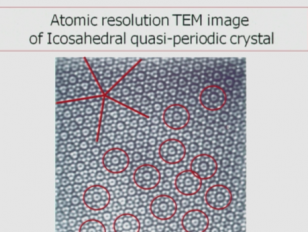The Discovery of Quasi-Periodic Materials

Presenter: Dan Schectman
Published: July 2014
Age: 18-22 and upwards
Views: 1989 views
Tags: crystallography;quasi-periodic;quasi;transmission;electron;microscope;tem
Type: Lectures
Source/institution: Lindau-Nobel
Watch now
Crystallography has been one of the mature sciences. Over the years, the modern science of crystallography that started by experimenting with x-ray diffraction from crystals in 1912 has developed a major paradigm Ð that all crystals are ordered and periodic. Indeed, this was the basis for the definition of ‘crystal’ in textbooks of crystallography and x-ray diffraction. Based upon a vast number of experimental data, constantly improving research tools, and deepening theoretical understanding of the structure of crystalline materials no revolution was anticipated in our understanding the atomic order of solids. However, such revolution did happen with the discovery of the Icosahedral phase, the first quasi-periodic crystal (QC) in 1982, and its announcement in 1984. QCs are ordered materials, but their atomic order is quasi-periodic rather than periodic, enabling formation of crystal symmetries, such as icosahedral symmetry, which cannot exist in periodic materials. QCs are quite abundant – hundreds of quasi-periodic crystals have been dis-covered by now. They are easy to make – practically all the techniques for metallic alloy making can produce QCs, and are made of simple frequently use elements – aluminum, iron, chromium and manganese to name a few. However it took 70 years, from 1912 to 1982 to discover the first QC. The reason is Transmission Electron Microscopy. The tool of choice in crystal structural analysis was x-ray diffraction. Indeed, the science was names “X-Ray Crystallography”. Although TEM is a powerful tool for the study of crystal structure, it was not recognized as such by the community of x-ray crystallographers. QCs had to be discovered by TEM, for the first QCs made by rapid solidification were small – a few microns in size at the most. It took the QC community 3 years to grow large enough QCs for x-ray diffraction to be performed on a single QC. This came only in 1987. The versatility of TEM that provided detailed contrast analysis as well as lattice imaging made the difference and enabled the discovery. This talk outlines the discovery of QCs and describes the important role of electron microscopy as a prime discovery tool.




